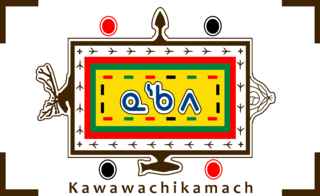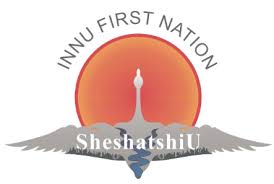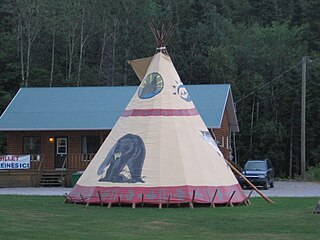
The Cree are a North American Indigenous people. They live primarily in Canada, where they form one of the country's largest First Nations. More than 350,000 Canadians are Cree or have Cree ancestry. The major proportion of Cree in Canada live north and west of Lake Superior, in Ontario, Manitoba, Saskatchewan, Alberta, and the Northwest Territories. About 27,000 live in Quebec.

The Innu / Ilnu or Innut / Innuat / Ilnuatsh ("people"), formerly called Montagnais from the French colonial period, are the Indigenous Canadians who inhabit the territory in the northeastern portion of the present-day province of Labrador and some portions of Quebec. They refer to their traditional homeland as Nitassinan or Innu-assi.

The Naskapi are an Indigenous people of the Subarctic native to the historical region St'aschinuw, which was located in present day northern Quebec and Labrador, neighbouring Nunavik. They are closely related to Innu People, who call their homeland Nitassinan.

The Chipewyan are a Dene Indigenous Canadian people of the Athabaskan language family, whose ancestors are identified with the Taltheilei Shale archaeological tradition. They are part of the Northern Athabascan group of peoples, and hail from what is now Western Canada.
Indigenous peoples in Quebec total eleven distinct ethnic groups. The one Inuit community and ten First Nations communities number 141,915 people and account for approximately two per cent of the population of Quebec, Canada.

Nutashkuan (INAC) or Natashquan (CGNDB) is a First Nations reserve in the Canadian province of Quebec, belonging to the Première Nation des Innus de Nutashkuan band. The reserve is located on the north shore of the Gulf of St. Lawrence at the mouth of the Natashquan River, 336 km (209 mi) east of Sept-Îles and has been accessible by Route 138 since 1996.
La Romaine, also known as Unamenshipit in Innu-aimun, is an Innu First Nations reserve in the Côte-Nord region of Quebec, Canada, at the mouth of the Olomane River on the Gulf of Saint Lawrence. It belongs to the Innu band of Unamen Shipu. Being an enclave within the Municipality of Côte-Nord-du-Golfe-du-Saint-Laurent, it is geographically within Le Golfe-du-Saint-Laurent Regional County Municipality but administratively not part of it. Directly adjacent to the reserve is the community of La Romaine consisting of a small French-speaking population.

The Sheshatshiu Innu First Nation is located in the province of Newfoundland and Labrador, Canada. This First Nations band government is centred on the community of Sheshatshiu.

Ahtahkakoop First Nation is a Cree First Nation band government in Shell Lake, Saskatchewan, Canada belonging to the Wāskahikaniwiyiniwak division of nēhiyawak. The Ahtahkakoop First Nation government and community is located on Ahtahkakoop 104, 72 kilometers northwest of Prince Albert and is 17,347 hectares in size. The community was formerly known as the "Sandy Lake Indian Band", a name which is still used interchangeably when referring to the reserve.
Mingan, also known as Ekuanitshit in Innu-aimun, is an Innu First Nations reserve, at the mouth of the Mingan River, on Mingan Bay, on the Nort shore of the Gulf of St. Lawrence. It belongs to the Innu band of Ekuanitshit, geographically it is within Cote-Nord region, Minganie Regional County Municipality, Quebec, Canada.
Pakuashipi is an Innu community in the Canadian province of Quebec, located on the north shore of the Gulf of Saint Lawrence in the Côte-Nord region. It is on the western shore of the mouth of the Saint-Augustin River, opposite the settlement of Saint-Augustin. It is not an Indian reserve, but an Indian settlement within the Municipality of Saint-Augustin, occupied by the Innu band of Pakua Shipi. Although they hold no formal legal title to the land at this time, negotiations are still ongoing to determine their indigenous rights.

Micmacs of Gesgapegiag are a Mi'gmaq First Nation in Quebec, Canada. They are based at Maria, Quebec on the Gaspé Peninsula and they have one Indian reserve, Gesgapegiag. In 2016 the band has a registered population of 1,501 members. The First Nation is part of the Mi'gmawei Mawiomi Secretariat.
Première Nation des Innus de Nutashkuan is an Innu First Nations band government in Quebec, Canada. The band lives on Nutashkuan, an Indian reserve in the Côte-Nord region. As of 2021, they have a registered population of 1,217 members. They are part of the Regroupement Mamit Innuat tribal council.

The Pessamit Innu Band, which the official name is bande des Innus de Pessamit, is an Indian band of the Innu First Nations in Quebec, Canada. Its members primarily live on the Indian reserve of Pessamit in the Côte-Nord, the north shore of Saint Lawrence River, which is also the seat of the band. In 2017 it has a registered population of 3,953 members. It is governened by a band council called Conseil des Innus de Pessamit and it is affiliated with the Mamuitun Tribal Council. The band was previously known as Bersimis and Betsiamites.
Innu Takuaikan Uashat Mak Mani-Utenam is an Innu First Nations band government in Quebec, Canada. It is based in Sept-Îles in the Côte-Nord region on the North shore of the Saint Lawrence River. It owns two reserves: Maliotenam 27A and Uashat 27 located at both ends of Sept-Îles. It is governed by a band council and is a member of the Mamuitun Tribal Council.

Innue Essipit is an Innu First Nation in Quebec, Canada. It owns one reserve named Essipit where one-third of its population live, located in the Côte-Nord region on the North shore of the Saint Lawrence River. This is one of the nine Innu communities in Quebec. In 2018, it had a total registered population of 756 members. It is part of the Mamuitun Tribal Council.
Naskapi Nation of Kawawachikamach is a First Nation band government in Quebec, Canada. The members of the band are ethnically Naskapi Innu and speak the Naskapi language. The Naskapi Nation of Kawawachikamach is the only Naskapi band in Quebec; there is another Naskapi band, Mushuau Innu First Nation located in Labrador.

Innu Nation of Matimekush-Lac John is a First Nation band government based out of Schefferville, Quebec, Canada. The members of the band are Innu people and speak the Innu language, an Algonquian language which is a member of the Cree–Montagnais–Naskapi dialect continuum.
The Assembly of First Nations Quebec-Labrador is a political organization representing the First Nations of Quebec and Labrador. It represents these First Nations to the Secrétariat aux affaires autochtones du Québec and to the ministry of Crown-Indigenous Relations and Northern Affairs of Canada. The AFNQL is composed of representatives from 43 communities in the Abenaki, Algonquin, Atikamekw, Cree, Maliseet, Mi'kmaq, Innu, Huron-Wendat and Naskapi nations, as well as from the Mohawks. The AFNQL does not represent the Inuit or any Inuit community; they are represented by Inuit Tapiriit Kanatami.











